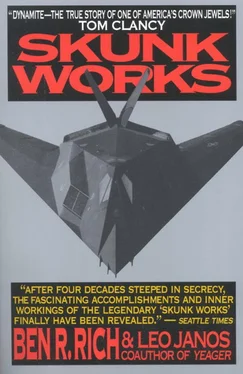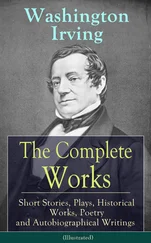“Bogie acquired, sir,” the radar operator tells the young captain in charge.
For a moment I’m startled, watching a moving blip that should not be. And it is big, unmistakable.
“Looks like a T-38, sir,” says the operator.
I exhale. The T-38 chase plane is being acquired by their radar detection. The radar operator has no idea that two airplanes should be on his scope—not one—and that he never did pick up Have Blue as it flew overhead.
“Sorry, sir,” the young captain says to me with a smug sneer. “Looks like your gizmo isn’t working too good.” Had this been a combat situation, the stealth fighter could have used high-precision, laser-guided bombs against the van and that smug captain would never have known what hit him. Might have taught him a lesson in good grammar too.
The van door opens and the young sergeant steps into the dark coolness, still looking as if he had hallucinated in the desert heat—seeing with his own eyes a strange diamond apparition that his missiles failed to lock onto.
“Captain,” he began, “you won’t believe this…”
THREE AND A HALF years earlier, on January 17, 1975, I drove to work in downtown Burbank, California, as I had for the past twenty-five years, only now I parked for the first time in the boss’s slot directly in front of an unmarked two-story windowless building that resembled a concrete blockhouse, in plain view of the main runway at Burbank’s busy Municipal Airport. This was Lockheed’s “Skunk Works,” which, throughout the long, tense years of the cold war, was one of the most secret facilities in North America and high on the targeting list of the Soviet Union in the event of nuclear war. Russian satellites regularly overflew our parking lot in the midst of Lockheed’s sprawling five-square-mile production complex, probably counting our cars and analyzing how busy we were. Russian trawlers, just outside territorial limits off the southern California coastline, trained powerful eavesdropping dishes in our direction to monitor our phone calls. We believed the KGB knew our key phone numbers, and computerized recording devices aboard those trawlers probably switched on when those phones rang. U.S. intelligence intercepted references to “the Skunk Works” regularly from Soviet satellite communications simply because there was no Russian translation for our colorful nickname. Our formal name was Lockheed’s Advanced Development Projects.
Even our rivals would acknowledge that whoever ran the Skunk Works had the most prestigious job in aerospace. Beginning with this mild day in January, that guy was me. I was fifty years old and in the pink.
Most Skunk Workers were handpicked by our just retired leader, Kelly Johnson, one of the reigning barons of American aviation, who first joined Lockheed in 1933 as a twenty-three-year-old fledgling engineer to help design and build the Electra twin-engine transport that helped put the young company and commercial aviation on the map. By the time he retired forty-two years later, Kelly Johnson was recognized as the preeminent aerodynamicist of his time, who had created the fastest and highest-flying military airplanes in history. Inside the Skunk Works, we were a small, intensely cohesive group consisting of about fifty veteran engineers and designers and a hundred or so expert machinists and shop workers. Our forte was building a small number of very technologically advanced airplanes for highly secret missions. What came off our drawing boards provided key strategic and technological advantages for the United States, since our enemies had no way to stop our overflights. Principal customers were the Central Intelligence Agency and the U.S. Air Force; for years we functioned as the CIA’s unofficial “toy-makers,” building for it fabulously successful spy planes, while developing an intimate working partnership with the agency that was unique between government and private industry. Our relations with the Air Force blue-suiters were love-hate—depending on whose heads Kelly was knocking together at any given time to keep the Skunk Works as free as possible from bureaucratic interlopers or the imperious wills of overbearing generals. To his credit Kelly never wavered in his battle for our independence from outside interference, and although more than one Air Force chief of staff over the years had to act as peacemaker between Kelly and some generals on the Air Staff, the proof of our success was that the airplanes we built operated under tight secrecy for eight to ten years before the government even acknowledged their existence. Time and again, our marching orders from Washington were to produce airplanes or weapons systems that were so advanced that the Soviet bloc would be impotent to stop their missions. Which was why most of the airplanes we built remained shrouded in the deepest operational secrecy. If the other side didn’t know these aircraft existed until we introduced them in action, they would be that much farther behind in building defenses to bring them down. So inside the Skunk Works we operated on a tight-lipped need-to-know basis. I figured that an analyst for Soviet intelligence in Moscow probably knew more about my Skunk Works projects than my own wife and children.
Even though we were the preeminent research and development operation in the free world, few Americans heard of the Skunk Works, although their eyes would light with recognition at some of our inventions: the P-80, America’s first jet fighter; the F-104 Starfighter, our first supersonic jet attack plane; the U-2 spy plane; the incredible SR-71 Blackbird, the world’s first three-times-the-speed-of-sound surveillance airplane; and the F-117A stealth tactical fighter that many Americans saw on CNN scoring precision bomb strikes over Baghdad during Operation Desert Storm.
These airplanes, and other Skunk Works projects that were unpublicized, shared a common thread: each was initiated at the highest levels of the government out of an imperative need to tip the cold war balance of power in our direction. For instance, the F-104, nicknamed “The Missile With the Man In It,” was an incredibly maneuverable high-performance Mach 2 interceptor built to win the skies over Korea in dogfights against the latest high-performance Soviet MiGs that had been giving our combat pilots fits. The U-2 spy plane overflew the Soviet Union for four tense years until luck ran out and Francis Gary Powers was shot down in 1960. The U-2 was built on direct orders from President Eisenhower, who was desperate to breach the Iron Curtain and discover the Russians’ potential for launching a surprise, Pearl Harbor–style nuclear attack, which the Joint Chiefs warned could be imminent.
And it is only now, when the cold war is history, that many of our accomplishments can finally be revealed, and I can stop playing mute, much like the star-crossed rabbi who hit a hole in one on the Sabbath.
I had been Kelly Johnson’s vice president for advanced projects and his personal choice to succeed him when he was forced to step down at mandatory retirement age of sixty-five. Kelly started the Skunk Works during World War II, had been Lockheed’s chief engineer since 1952, and was the only airplane builder ever to win two Collier Trophies, which was the aerospace equivalent of the Hollywood Oscar, and the presidential Medal of Freedom. He had designed more than forty airplanes over his long life, many of them almost as famous in aviation as he was, and he damned well only built airplanes he believed in. He was the toughest boss west of the Mississippi, or east of it too, suffered fools for less than seven seconds, and accumulated as many detractors as admirers at the Pentagon and among Air Force commanders. But even those who would never forgive Johnson for his bullying stubbornness and hair-trigger temper were forced to salute his matchless integrity. On several occasions, Kelly actually gave back money to the government, either because we had brought in a project under budget or because he saw that what we were struggling to design or build was just not going to work.
Читать дальше












